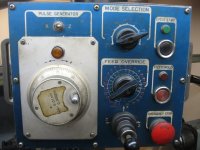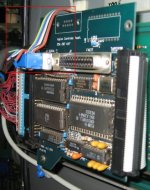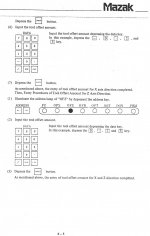After looking at the pics of the control, its quit different from the 6t i have. But as far as the way the G50s and such work, if you run into any trouble, feel free to call me at the number i sent on the PM. Best of luck.
As far as the functionality goes, the Series 5 and 6 are the same. Some of the very early 6TA controls actually had the same 7 segment Address display (no CTR screen) as the 5T and it was hard to tell the two controls apart. The biggest difference between the Series 5 and Series 6 control is that the Series 6 tolerates periods (decimal points) in the program address words.
Garwood,
The most important thing to be aware of when using G50 to set the coordinate system is that each tool must be located at same point every time the G50 command is executed. Accordingly, the tool change position needs to be at an easily repeatable position, like Reference Return for example.
Mazak M4 and M5 turning centres came in quite a few length configurations; generally 1.5M plus. To accommodate short work, there is a moveable Z Zero return dog on a bar calibrated in 10mm increments, tucked under the front of the bed-way. This is used to reposition the Z axis Reference Return position, and therefore eliminate the need to go way up the bed-way to execute a Z Reference Return.
Unlike a control using Geometry Offset Programming, where, if the program is aborted due to a failed insert or for whatever reason, the program can be repeated with the Tool parked in any safe position, a machine using G50 to set the coordinate system must have the tool start from exactly the same point before the G50 command is executed. As mentioned earlier, this position is frequently the X,Z Reference Return location, as its an easily locatable position. If a production job is being run, where you may wish to limit the amount of Rapid Travers move from Tool Change position to Workpiece, the following can be used throughout the program in the event that the program has to be aborted and restarted:
(Metric Example)
N1 G00 G21 G40
/G28 U0 W0
/G00 U-150000 W-200000
G50 X250000 Z150000 (OR WHATEVER IT MAY BE)
G50 T0100 S2500
G96 S200 M03
G00 X100000 Z10000 T0101 M08
---------
---------
---------
---------
G00 X250000 Z150000 T0100 M09
M01
(NEXT TOOL)
/N2 G28 U0 W0
/G00 U-150000 W-200000
G50 X220000 Z100000 (OR WHATEVER IT MAY BE)
G50 T0200 S2500
G96 S200 M03
G00 X100000 Z10000 T0202 M08
---------
---------
---------
---------
G00 X220000 Z100000 T0200 M09
M01
and so on.
Always select a tool without an offset, for example T0100 and not T0101. Then apply the offset on the next move command. To call the tool with T0101 will result in the carriage moving the Tool Offset amount during the tool index. If the carriage is parked at the Reference Return position and the Offset amount is considerable, the slide can move into Over-travel. Also, its important that the Tool Offset is cancelled as the tool is returned to the Tool Change position. Not observing this precaution will result is a gradual shift of the Tool Change position and ruination of the workpiece.
By having the following with a block delete,
/N2 G28 U0 W0
/G00 U-150000 W-200000
anytime a Tool Change position other than the Reference Return position needs to be found, it can easily be done so by turning the Block Delete switch off and allowing the first two blocks to execute. Once back at the Tool Change position, the Block Delete switch is turned back on.
There are many ways to determine the G50 value for each tool, following is one that's fairly reliable.
1. Reference Return both axes.
2. Zero both the X and Z position display by pressing the corresponding buttons to the right of each display.
3. Manually index the required too into position.
4. Manually start the spindle and adjust RPM to an acceptable level to take a cut on a workpiece mounted in whatever the work-holding device is.
5. Move the tool to the workpiece and take a light cut on the OD.
6. Clear the tool of the workpiece in Z only without moving the tool in X.
7. Stop the spindle, measure the workpiece and note.
8. The values shown in the position display is the distance the tool tip is from the Reference Return position, displayed as a negative value. Add to the X value, the diameter measurement of the workpiece as a negative value. The positive of the result is the G50 for X when the X slide is at the X Reference Return position.
9. Start the spindle and take a light cut on the end of the workpiece.
10. Clear the tool of the workpiece in X only and without moving the tool in Z. Measure from the end of the machined workpiece to where Z Zero is for this workpiece.
11. If there is, say, 1.05mm between the current machined end and Z Zero, add as a minus value 1.05mm to the current negative value being shown on the Z position display. The positive of the result is the G50 for Z when the Z slide is at the Z Reference Return position.
12. If the tool change X,Z position is to be set distances away from the Reference Return positions, subtract these distances from the results gained in 8 an 11 above to obtain the X, Z G50's for this location.
13. Repeat the above for all other tools to be set.
14. As the position display was initially Zeroed at the Reference Return position, the tool turret does not require to be Homed between the setting of each tool. Just move the carriage to a safe Tool Change position and select the next tool.
15. The above example is for an OD tool. The same procedure is followed to set an ID tool, except, obviously, a bore is cut and measured to gain the X G50.
Its seldom that the G50's will be whole, round numbers. For this reason, I advise my clients to use the Integer component of the result gained in 8, 11, or 12, and use the decimal component as the Tool Offset. This works out well when the control is used in the Metric Mode, as the decimal component will always be quite small, less than 0.040". When using the Imperial system, I round down to the closest 0.5" increment and use the remainder as the Tool Offset. This method will consistently result in Mono Direction offsets and round, clean numbers as G50's in the program.
Its likely that your lathe has a rear turret for Internal Tools. This being the case, the X G50's will be all Negative values for the back turret tools. When programming Circular Interpolation moves for the back turret, the direction of G02/G03, when viewed from above, is reversed. For example, a clockwise move will be G03.
Single blocks of program data can be executed via MDI. For example, to move the X, Z slides incrementally -100.00 and -150.00 respectively, proceed as follows:
1. Select MDI Mode
2. Via the Address arrows, select G Address
3. Enter 00 via the Keypad and press the Input button
4. Select Address U. Note, if you press and hold down the Right Address arrow, the LED cursor will move continuously. To move the Address LED to the left, the Left Address arrow has to be pressed and released between single Address LED moves.
5. Enter -100000 and press Input
6. Select Address W
7. Enter -150000 and press Input
8. Depending on parameter settings, pressing the Start button near the Keypad will execute the block just entered. If the block does not execute when the Start button is pressed, press the Cycle Start button. Cycle Start will execute the block in MDI irrespective of the parameter setting.
I hope the above is clear and helpful to you.
Regards,
Bill






